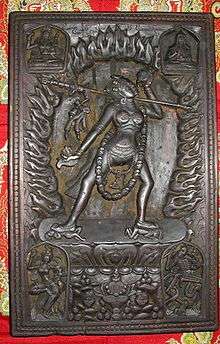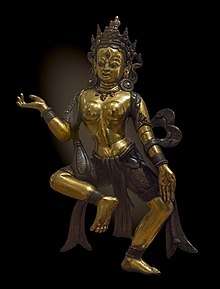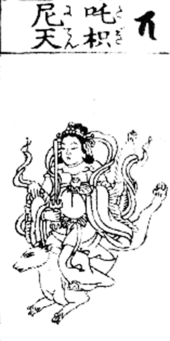Dakini
A ḍākinī (Sanskrit: डाकिनी; Tibetan: མཁའ་འགྲོ་མ་, Wylie: mkha' 'gro ma, THL: Khandroma ; Mongolian: хандарма; Chinese: 空行母; pinyin: Kōngxíng Mǔ; alternatively Chinese: 荼枳尼; pinyin: Túzhǐní) is a type of sacred female spirit in Hinduism and Vajrayana Buddhism. The term can also be applied to human women with a certain amount of spiritual development. The Sanskrit term is related to ḍīyate - to fly, as in uḍḍayanam (meaning flight). The Tibetan term means "skygoer" and may have originated in the Sanskrit khecara, a term from the Cakrasaṃvara Tantra.[1] Dakinis are often represented as consorts in Yab-Yum representations. The masculine form of the word is ḍāka, which is usually translated into Tibetan as pawo "hero" (Wylie: dpa' bo ).[1]

| Part of a series on |
| Vajrayana Buddhism |
|---|
 |
|
Traditions Historical traditions:
New branches:
|
|
History |
|
Pursuit |
|
Practices
Fourfold division: Twofold division: Thought forms and visualisation: Yoga:
|
|
Festivals |
|
Tantric texts |
|
Ordination and transmission |
The ḍākinī (and the ḍāka) appeared in medieval legends in India (such as in the Bhagavata Purana, Brahma Purana, Markandeya Purana and Kathasaritsagara) as a demon in the train of Kali who feeds on human flesh.[2] Devi Kavacham in Marakandeya Purana provides protection against Dakini and others.[3][4]
As a key tantric figure, the ḍākinī does appear in Tangmi; the ḍākinī figure disseminated into Japanese culture from Shingon Buddhism, evolving into the dakini-ten ("ten" means "deva" in Japanese), becoming linked to the kitsune iconography.
The ḍākinī appears in a Vajrayana formulation of the Buddhist refuge formula known as the Three Roots. Sometimes she appears as the dharmapala, alongside a guru and yidam.
- The dakini, in her various guises, serves as each of the Three Roots. She may be a human guru, a vajra master who transmits the Vajrayana teachings to her disciples and joins them in samaya commitments. The wisdom dakini may be a yidam, a meditational deity; female deity yogas such as Vajrayogini are common in Tibetan Buddhism. Or she may be a protector; the wisdom dakinis have special power and responsibility to protect the integrity of oral transmissions"[5]
The archetypal ḍākinī in Tibetan Buddhism is Yeshe Tsogyal, consort of Padmasambhava.[1]
In Buddhism
In Tibetan Buddhism
Although ḍākinī figures appear in Hinduism and Bon, ḍākinīs occur most notably in Vajrayana Buddhism and especially Tibetan Buddhism. The khandroma, generally of volatile or wrathful temperament, acts somewhat as spiritual muse for spiritual practice. Dakinis are energetic beings in female form, evocative of the movement of energy in space. In this context, the sky or space indicates śūnyatā, the insubstantiality of all phenomena, which is, at the same time, the pure potentiality for all possible manifestations.
Classes of ḍākinī
Judith Simmer-Brown, based on teachings she received from Tibetan lamas,[6] identifies four main classes of ḍākinī. These follow the twilight language tradition of esoteric Buddhism in referring to secret, inner, outer and outer-outer classes of ḍākinīs.
- The secret class of ḍākinī is prajnaparamita (Tibetan yum chenmo), the empty nature of reality according to Mahayana doctrine.
- The inner class of ḍākinī is the ḍākinī of the mandala, a meditational deity (Tibetan:yidam) and fully enlightened Buddha who helps the practitioner recognise their own Buddhahood.
- The outer ḍākinī is the physical form of the ḍākinī, attained through completion stage tantra practices such as the Six Yogas of Naropa that work with the subtle winds of the subtle body so that the practitioner's body is compatible with an enlightened mind.
- The outer-outer ḍākinī is a ḍākinī in human form. She is a yogini in her own right but may also be a karmamudrā, or consort, of a yogi or mahasiddha.
Dakinis can also be classified according to the Trikaya, or three bodies of buddhahood.
- The Dharmakāya ḍākinī, which is Samantabhadrī, represents the dharmadhatu where all phenomena appear.
- The Sambhogakāya ḍākinīs are the yidams used as meditational deities for tantric practice.
- The Nirmanakāya ḍākinīs are human women born with special potentialities; these are realized yoginis, consorts of gurus, or even all women in general as they may be classified into the Five Buddha Families.[7]
In Dzogchen

When considered as a stage on the Vajrayana Path, the ḍākinī is the final stages: the first is the guru, which corresponds to the initial realization of the true condition of reality, as this is introduced by the guru in the empowerment, if the disciple obtains what the Inner Tantras call peyi yeshe (Wylie: dpe yi ye shes ) or the clarity of shunyata. The second is the devata, which corresponds to the meditation insofar as the devata is the method used for developing the state discovered in the initial realization of the true condition of reality. The third stage is the ḍākinī insofar as the ḍākinī is the source of the activities based on the realization of the guru and the meditation of the devata.
In Dzogchen these three correspond to tawa (lta ba), gompa (sgom pa) and chöpa (spyod pa): the first is the direct vision of the true nature of reality rather than an intellectual view of reality, as is the case with the term in other vehicles; the second is the continuity of this vision in sessions of meditation; and the third is the continuity of this vision in everyday activities. As a tantric practice, imperfections are utilised to make the vision uninterrupted. As the Base, the ḍākinīs are the energies of life; as the Path, they are the activities of advanced practitioners; as the Fruit, they are the actionless activities of realized Masters.[7]
In Anuttarayoga Tantra
Being associated with energy in all its functions, ḍākinīs are linked with the revelation of the Anuttarayoga Tantras, which represent the path of transformation, whereby the energy of negative emotions or kleshas, called poisons, is transformed into the luminous energy of enlightened awareness yielding the most profound experience of clear light. Thubten Yeshe explains:
When the completion stage practices have been mastered and we have gained control over our subtle energy winds and so forth, there will come a time when the dakas and dakinis will come... physically embracing such a consort is necessary to bring all the pervading energy winds into the central channel, a prerequisite for opening the heart center and experiencing the profoundest level of clear light.[8]
Daka
In some instances, the terms ḍāka and ḍākinī have been used for practitioners of tantric yoga themselves. In other instances, just ḍākinī was used for female practitioners, while male practitioners were just known as yogi. Padmasambhava was known as a yogi and Yeshe Tsogyal, a Tibetan princess, yogini and consort of Padmasambhava, as a ḍākinī.
Miranda Shaw, associate professor of religion at University of Richmond, said in an interview in 1995, "In Sanskrit there is only one word, Dakini. There are only female Dakinis... there is no male Dakini. It is an impossibility and a contradiction in terms."[9]
Whereas Jan Willis in the chapter Ḑākinī; Some Comments on Its Nature and Meaning points out that "'she' is not 'female'. Though the ḍākinī assuredly most often appears in female form... this is but one of the myriad of ways Absolute Insight chooses to make manifest its facticity".[10]
Tibetan Lamas trained in the Gelug school, such as Sermey Khensur Lobsang Tharchin[11] and Kelsang Gyatso,[12] and those of the Karma Kagyu school such as Khenpo Karthar Rinpoche,[13] write freely of "dakas and dakinis". Thubten Yeshe clarifies their meaning: "what are dakas and dakinis? Simply speaking they are males and females who possess advanced experiences of tantric transformation and control and are therefore able to increase the blissful wisdom of a highly qualified practitioner".[14]
In Japanese Buddhism

She always appears in the form of riding on a white fox. 1783
Although the ḍākinī imagery appears to have come to Japan via Kūkai's introduction of Tangmi in Shingon Buddhism in the early 9th century; her form appears more like the ḍākinīs of Hindu iconography than those found in Tibetan Buddhism.[15] During the decline of the Heian period, the ḍākinī image was mixed together with images of foxes and half-naked women, acquiring the names Dakini-ten (荼枳尼天, Dakini-deity), Shinkoō-bosatsu (辰狐王菩薩, Star Fox Queen-Bodhisattva), and Kiko-tennō (貴狐天王, Noble Fox-Heavenly Queen). In the Middle Ages, the Emperor of Japan would chant before an image of the fox Dakini-ten during his Enthronement, and both the shōgun and the emperor would venerate Dakini-ten whenever they saw it, as it was a common belief at the time that ceasing to pay respects to Dakini-ten would cause the immediate ruin of the regime.
Although Dakini-ten was said to be a powerful Buddhist deity, the images and stories surrounding it in Japan in both medieval and modern times are drawn from local kitsune mythology. The modern folk belief, often printed in Japanese books about religion, is that the fox image was a substitute for the Indian jackal, but the black jackal and other black animals are associated with Kali. As another example of the connection between Dakini-ten and the government of Japan, in the Genpei Jōsuiki it is claimed that Taira no Kiyomori met a kitsune on the road and that his subsequent performance of Dakini-ten rites caused him to rise from an unimportant clan leader to the ruler of the entire nation.[16] In the early modern period, the ḍākinī rite devolved into various spells called Dakini-ten, Atago Gongen. Those who felt wronged in their village could go to a corrupt yamabushi who practiced black magic, and get him to trap a kitsune and cause it to possess a third party.[17] Reports of possession became especially common in the Edo and Meiji periods. For details, see kitsunetsuki.
References
- Jr., Robert E. Buswell; Ziegler, Donald S. Lopez Jr.; with the assistance of Juhn Ahn, J. Wayne Bass, William Chu, Amanda Goodman, Hyoung Seok Ham, Seong-Uk Kim, Sumi Lee, Patrick Pranke, Andrew Quintman, Gareth Sparham, Maya Stiller, Harumi (2013). Princeton Dictionary of Buddhism. Princeton, NJ: Princeton University Press. ISBN 9780691157863.
- Monier-Williams, A Sanskrit Dictionary 1899
- https://sanskritdocuments.org/doc_devii/durga700.html?lang=sa
- http://webstock.in/001-Epics-PDF/Durga-Saptashati-Sanskrit-Hindi/001-Durga-Saptashati-Sanskrit-Hindi.pdf
- Simmer-Brown, Judith (2002). Dakini's Warm Breath:The Feminine Principle in Tibetan Buddhism. Shambhala Publications Inc. pp. 139–40. ISBN 978-1-57062-920-4.
- Simmer-Brown, Judith (2002). Dakini's Warm Breath:The Feminine Principle in Tibetan Buddhism. Boston and London: Shambhala Publications Inc. pp. 69–79. ISBN 978-1-57062-920-4.
- Cf. Capriles, Elías (2003/2007). Buddhism and Dzogchen"BDZ E Version" (PDF). Archived from the original (PDF) on July 17, 2011. Retrieved July 17, 2011., and Capriles, Elías (2006/2007). Beyond Being, Beyond Mind, Beyond History, vol. I, Beyond Being'
- Yeshe, Lama (2001). Introduction to Tantra: The Transformation of Desire. Wisdom Publications. p. 135. ISBN 978-0-86171-162-8.
- Powers, Tashi. "Interview with Miranda Shaw". Enlightening Times. Retrieved 2012-09-21.
- Willis, Janice D. (1995). Feminine Ground: Essays on Women and Tibet. Snow Lion Publications. pp. 57–96. ISBN 9781559390521.
- Tharchin, Sermey Khensur Lobsang (1997). Sublime Path to kechara Paradise: Vajrayogini's Eleven Yogas of Generation Stage Practice. Howell, New Jersey: Mahayana Sutra and Tantra Press. p. 94. ISBN 978-0-918753-13-7.
- Gyatso, Kelsang (1999). Guide to Dakini Land: The Highest Yoga Tantra practice of Buddha Vajrayogini. Tharpa Publications. p. 188. ISBN 978-0948006-39-5.
- Karthar Rinpoche, Khenpo (2006). Karma Chakme's Mountain Dharma, Vol 2. KTD Publications. p. 289. ISBN 978-0-9741092-1-3.
- Yeshe, Lama (1999). Introduction to Tantra: The Transformation of Desire. Wisdom Publications. p. 135. ISBN 978-0-86171-162-8.
- Boscaro, Adriana (2003). Rethinking Japan: Social Sciences, Ideology and Thought. Curzon Press. p. 330. ISBN 978-0-904404-79-1.
- Smyers, Karen Ann (1999). The fox and the jewel: shared and private meanings in contemporary Japanese inari worship. University of Hawaii Press. p. 84. ISBN 978-0-8248-2058-9.
- Blacker, Carmen (1999). TheCatalpa Bow: A Study of Shamanistic Practices in Japan. Psychology Press. ISBN 978-0-203-34713-3.
Further reading
- Campbell, June (1996). Traveller in Space: In Search of the Female Identity in Tibetan Buddhism. George Braziller. ISBN 978-0-8076-1406-8.
- English, Elizabeth (2002). Vajrayogini: Her Visualizations, Rituals, and Forms. Wisdom Publications. ISBN 978-0-86171-329-5.
- Haas, Michaela (2013). Dakini Power: Twelve Extraordinary Women Shaping the Transmission of Tibetan Buddhism in the West. Snow Lion. ISBN 978-1559394079.
- Norbu, Thinley (1981). Magic Dance: The Display of the Self Nature of the Five Wisdom Dakinis (2nd ed.). Jewel Publishing House. ISBN 978-0-9607000-0-4.
- Padmasambhava; Kunsang, Erik Pema (tr.) (1999). Dakini Teachings (2nd ed.). Rangjung Yeshe Publications. ISBN 978-962-7341-36-9.
External links
| Wikimedia Commons has media related to Dakinis. |